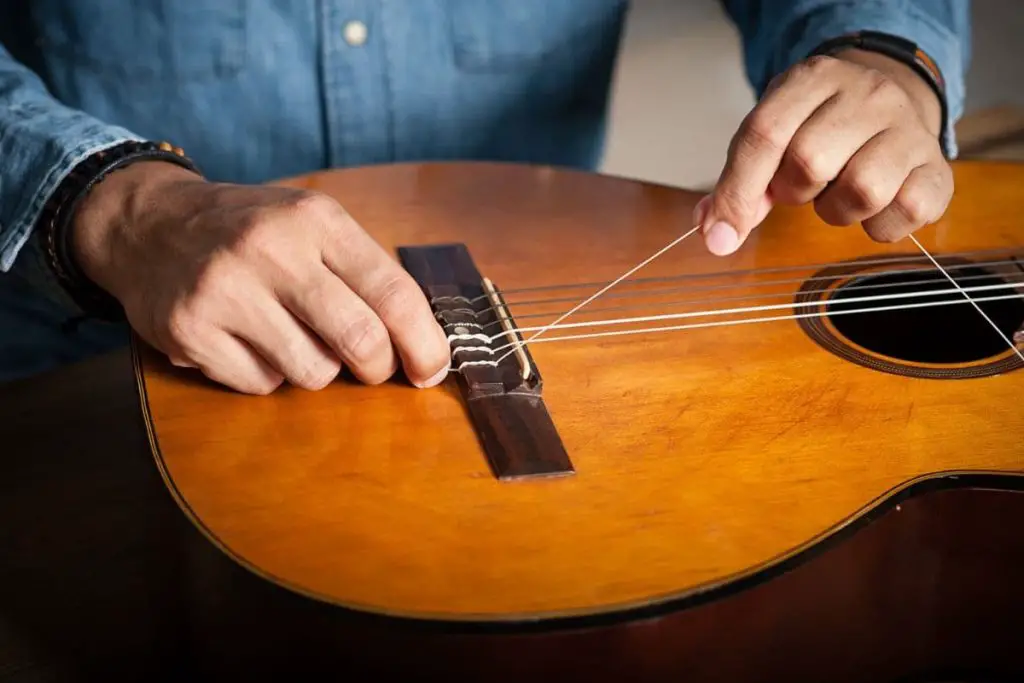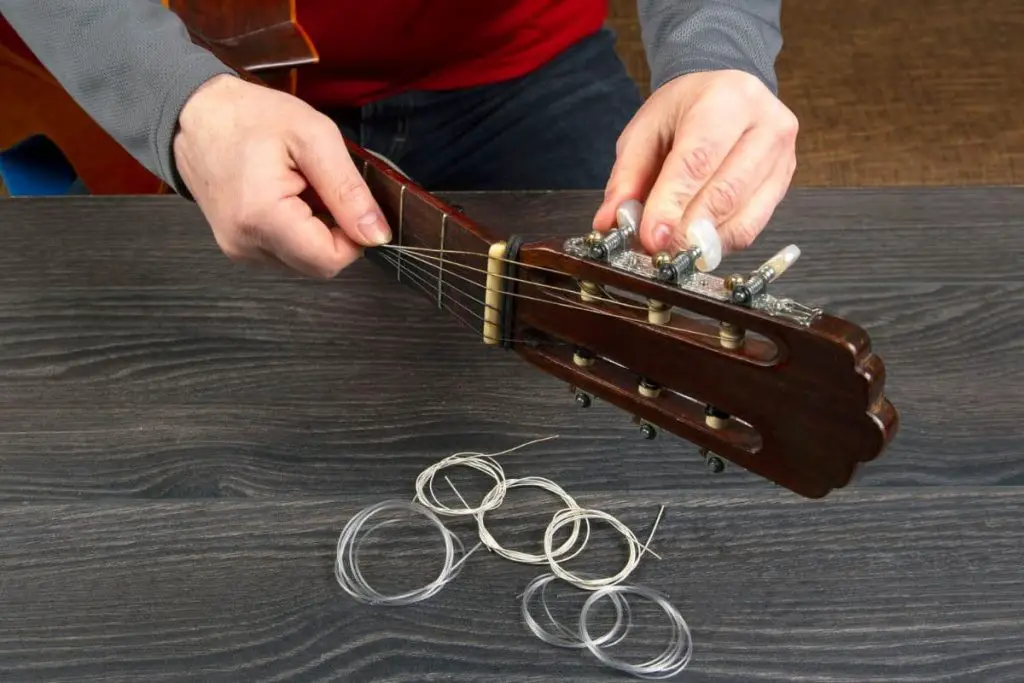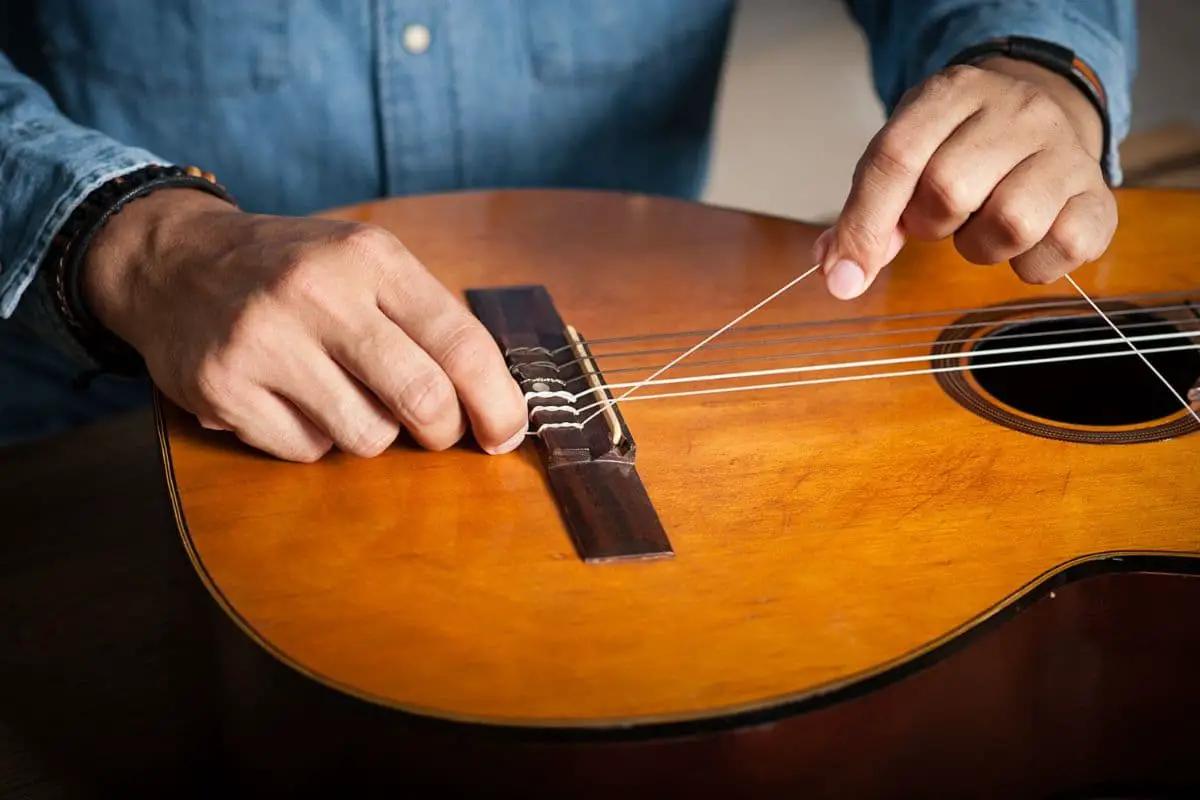Nylon guitar strings are light, mellow, and easy to pick. However, they’re known to stretch more than most strings due to their natural flexibility. If your nylon guitar strings don’t stop stretching, they’ll ruin the intonation and become nearly impossible to strum or pick. The good news is that there are plenty of things you can do to stop the overstretching process.
When your nylon guitar strings keep stretching, try reducing the action, manually stretching the strings to their limits, and tuning them. You could also try longer practice sessions to break the strings in or change the tuning pegs. Keep in mind that guitar strings need to stretch for a few days.
In this post, we’ll break down what you can do to stop your nylon guitar strings from stretching, how to prevent it from happening down the road, and why nylon strings stretch so much. Enjoy!
If you want to find out what my recommended guitar gear is, then here is what I recommend on Amazon:
- Fender Cutaway Acoustic-Electric Guitar Bundle (MY FAVORITE GUITAR)
- Snark SN-8 Super Tight All Instrument Tuner (Easiest Tuner I’ve Used)
- 6 String Acoustic Guitar Capo (Best CAPO for quick changes)
- Dunlop Max Grip 1.0mm Nylon Picks (Thick Guitar Pick So You Don’t Lose Grip!)
- Universal Guitar Stand (Cheap & Minimalist Guitar Stand I Recommend)
- Levy’s 2″ Wide Quick Adjust Guitar Strap (Best Guitar Strap For Any Level)

Do Nylon Guitar Strings Stretch?
Nylon guitar strings can stretch after they are installed on the guitar. In fact, it is normal for new strings to stretch, as they settle in and adjust to the tension of the instrument.
When you first install new nylon strings, it is important to tune them up to pitch and then gently stretch them out by pulling on them from the middle of the fretboard to the end of the fingerboard. This will help relieve any tension in the strings and prevent them from going out of tune.
After you have stretched the strings, you should tune the guitar up to pitch again and then continue to play it for a while. During this time, the strings will settle in and stretch out further, which can cause them to go out of tune again.
Over time, as the strings continue to settle in and stretch out, they will become less prone to going out of tune and require less adjustment. However, it is still important to monitor the tuning and make adjustments as necessary, especially during the first few days after installing new strings.
Overall, while nylon guitar strings can stretch, this is a normal part of the installation process and can be managed with proper tuning and stretching techniques.
Do nylon strings stop stretching?
Yes, nylon strings will eventually stop stretching after they have been installed on a guitar and stretched out several times. This process of settling in and stabilizing can take several days to a week, depending on how often the guitar is played and how often the strings are tuned.
As the strings settle in and stabilize, they will become less likely to go out of tune or require re-stretching. However, it is important to continue to monitor the strings and adjust the tuning as necessary, especially during the first few days after installation.
It is also worth noting that nylon strings can be more susceptible to environmental factors that can cause them to stretch or go out of tune. For example, changes in temperature or humidity can affect the tension of the strings and cause them to stretch or shrink. In such cases, it may be necessary to adjust the tuning or re-stretch the strings to compensate for these changes.
Overall, while nylon strings will eventually stop stretching, it is important to continue to monitor and adjust the tuning as necessary to ensure the best possible playing experience.
Tips for Stretching Out New Nylon Guitar Strings
Stretching out new nylon guitar strings is an important step in the process of installing them on your guitar.
Here are some tips for stretching out new nylon guitar strings:
- Tune up the strings: Before stretching out new nylon guitar strings, it is important to tune them up to pitch. This will help the strings settle into their final position and make them easier to stretch.
- Gently stretch the strings: Once the strings are tuned up to pitch, gently pull on each string from the middle of the fretboard to the end of the fingerboard. Do this several times for each string to help stretch out the string and relieve any tension.
- Retune the strings: After stretching out each string, retune the guitar to pitch. The strings will likely have gone flat from being stretched, so retuning them will ensure that they are back in tune.
- Repeat the process: Continue to stretch out the strings and retune the guitar until the strings no longer go out of tune after being stretched.
- Use caution: Be careful not to over-stretch the strings, as this can cause them to break. Stretching the strings gently and gradually is the best way to ensure that they settle into their final position without breaking.
- Play the guitar: After the strings have been stretched and tuned, play the guitar for a while to help the strings settle in and achieve their best tone.
By following these tips, you can stretch out new nylon guitar strings and achieve a better playing experience with your instrument.
How to Make Nylon Guitar Strings Stop Stretching
To make nylon strings stop stretching, try these five tips:
- Reduce the guitar’s action. If the action is too high, it’ll put constant tension and strain on the nylon strings. Low the action by rotating the adjustment nut to lower the truss rod. You can also file the underside of the nut and the saddle if the truss rod won’t lower the action enough to stop stretching the strings.
- Manually stretch the strings. Stretching the strings will prevent them from non-stop stretching when you practice or perform. This process typically consists of bending the strings up and down, hammering on and off, and more. We’ll cover a detailed method later in the article.
- Tune the strings correctly. If you tune the strings without threading about 1.5 to 2 inches of nylon through the tuning peg, you’ll overstretch them every time. Slide this measurement through the hole, wrap it to face outward, then wind the tuning peg while firmly holding the bridge pin with the other hand.
- Practice for a couple of hours daily for a few days. Strumming, fingerpicking, and fretting the guitar are the best ways to stretch the nylon strings. Since stretching the strings stops them from slowly stretching down the road, you can fastrack the process. Remember to be gentle with new guitar strings, especially with nylon.
- Change the tuning pegs. Tuning pegs get worn under the pressure of the strings. This process typically takes several years, but it can strain and stretch the strings. If your tuning pegs are loose or bent in a different direction, it’s time to swap them out. Get a new set of like-for-like tuning pegs and replace each of them.
It’s important to remember that nylon strings stretch more than steel strings. If you’re used to steel strings, a new nylon set might take a bit of getting used to. Fortunately, there are quite a few things that affect how long it takes for the strings to stretch. Read on for more details regarding a nylon guitar string stretching timeline.
How Long Do Nylon Strings Take to Stretch? (Settle & Break in)
Nylon guitar strings take up to 4 days to stretch, settle, and break in. However, it depends on how often you strum and fingerpick. If you play your guitar for several hours each day, it might only take a couple of days for your nylon strings to break in. Those who only go with 30-minute practice sessions might find it could take up to a week for the strings to stretch completely.

These factors influence how long it takes for your nylon guitar strings to stretch:
- How often you play the guitar: According to Tone Topics, nylon strings usually take between two to four days to stop stretching. Once they’re broken in, you don’t have to worry about them stretching other than when you tune them. Playing the guitar more often and in longer sessions will reduce the stretching time.
- The quality of the nylon strings: If you choose high-end nylon strings, they typically don’t take too long to break in. Not only that, but they last longer and hold their intonation much better. It’s worth spending a little bit more to get top-shelf nylon strings if you want to accelerate the stretching process.
- Whether or not you manually stretch the strings: If you stretch the strings right when you attach them to the guitar, they’ll finish stretching much sooner. There’s no doubt that they’ll still take a couple of days to break in, but you won’t have to deal with constantly tuning the guitar. It only takes a couple of minutes to manually stretch nylon strings.
- The guitar’s truss rod: If the truss rod is flat, the strings will naturally stretch. However, if the truss rod is slightly bowed inward, there won’t be enough tension on the strings to stretch them. Make sure the guitar neck is as flat as possible. If the strings buzz, take a little bit of pressure off of the truss rod.
- The style of playing you prefer: If you strum heavy, you’ll likely stretch the strings pretty quickly. Make sure you don’t slam the nylon strings when you first install them. These strings are quite flexible, but they’ll bend and break if they’re not gradually stretched. Fingerpicking is a bit slower when it comes to stretching nylon strings.
Keeping these factors in mind, you can expect most nylon strings to stretch for less than a week. If your strings keep stretching, there’s likely an issue with the instrument. They also might stretch for a bit longer if you don’t play the guitar for several days after installing the new nylon strings. However, there are a handful of reasons your nylon strings might not stop stretching.
Why Won’t Nylon Guitar Strings Stop Stretching?
Your nylon strings won’t stop stretching because the action is too high, they’re brand new strings, your tuning pegs are cranked backward, or they’re tuned too tightly. Another possibility is that you have your nylon strings tuned in the wrong key, which means they’re a full octave higher than they should be.

Let’s take a deeper look at each of these possible causes:
- The action needs to be adjusted. While all guitar strings eventually stop stretching, some take a little more time than others. If you feel like your nylon strings are constantly stretching, consider adjusting the action. When the action is too tight, it’ll pull the strings from both sides until they snap.
- The nylon strings are brand-new. Nylon strings are as stretchy as can be. They’re often considered to be the most flexible guitar strings. However, this means you’ll have to deal with a lot of natural stretching, tuning, etc. Wait for a few days (or about three to five hours) of practicing before worrying if there’s a problem.
- The tuning pegs are misaligned. If your guitar’s tuning pegs are facing anywhere other than they’re supposed to, they’re going to have a negative impact on your strings. When they lean back, they put a lot of stretching pressure on the strings. This means you’ll have to loosen them, straighten them, and tighten them with a screwdriver.
- The strings are tuned too tightly. It could be tempting to continuously tighten the strings. Another common issue is not putting enough extra string through the tuning peg, as mentioned before. Either way, turning the tuning pegs until the strings are too tight will make them stretch until they break.
- The strings are tuned to a higher key. If you use a digital recorder, it’ll tell you when the E string is an E, when the D string is a D, and so on. However, if you get to a higher key, some tuners will register a high E and a low E as the same thing. You could end up tuning the nylon strings one octave higher, stretching them too much.
On the bright side, you can almost always fix overstretched nylon guitar strings if it’s not too late. Just because they’re stretched a bit too far doesn’t mean you can’t fix the issue. In the next section, we’ll break down a step-by-step process to help you fix your nylon strings and prevent them from stretching anymore.
How to Fix Overstretched Nylon Strings?
To fix overstretched nylon strings, follow these instructions:
- Tune the strings, bend them, and tune them again. Tuning the strings will help them reach their stretching limit, especially if you repeat the process several times per day. You don’t have to make massive adjustments to stretch the strings. Some guitarists tune their strings one key higher, then reduce the strings to the designed key.
- Remove the strings from the guitar and let them sit for a few hours. Removing the strings will let them compress. Nylon’s flexibility lets them expand and contract quite a bit. If you set them aside for a short period of time, you’ll be surprised by how much elasticity returns to the strings.
- Put the nylon strings back on the guitar. Don’t leave them off the instrument for too long. Once they lose their flexibility, there’s no getting it back. Start by sliding the ball end of the string under the bridge pin, then push the pin while stretching each string toward the tuning pegs.
- Leave an inch and a half of extra string to wrap around each tuning peg. If you turn the tuning peg while there’s barely any nylon coming through the other side, it’ll pull the string out of the bridge pin. It could also stretch the nylon too much, causing weak spots and potential breakages down the road.
- Make sure the strings are inside the tuning pegs on the headstock. The string should never be wrapped around the outside of the tuning peg. For instance, the three highest strings should be wrapped counterclockwise, and the three lowest strings should be wrapped clockwise around the tuning peg.
Overstretched nylon strings are quite rare. It takes a while for the strings to reach their maximum length and flexibility. They’re unlikely to stretch too far without direct, intentional input. If you’re thinking about stretching your nylon guitar strings to prevent them from stretching while you’re playing the instrument, read on.
Do You Have to Stretch New Nylon Guitar Strings?
You have to stretch new nylon strings because the material is naturally flexible. If you don’t stretch the strings, they’ll randomly stretch throughout your practice sessions. It’s best to stretch them as soon as possible to prevent unwanted intonation problems, overstretched strings, excessive retuning, and so on.

Here’s a quick way to stretch your nylon strings, so they don’t stretch while you’re strumming:
- Place your left hand over the strings on the fourth fret. You can start with any fret near the top of the neck, but the fourth fret is typically a perfect starting position. It lets you maintain firm pressure on the strings while stretching the portion between the frets and the bridge (or whichever stopping point you choose).
- Put your right hand on one string on the 12th fret. Reverb recommends stretching the strings from multiple positions, including the 7th and 12th frets. Keep in mind that you can stretch the strings from only any position. The main thing to keep in mind is that there should be a few frets between your left and right hands.
- Bend the string up, hold it, then bend it down and hold it. This technique works very similar to bending the strings while picking. It changes the pitch, but it also stretches the strings. Nylon bends quite easily, so make sure you take this process slowly to prevent overstretching the strings or causing weak spots.
- Firmly but gently push down on each of the strings behind the nut. People often forget this portion of the strings. However, they directly impact how much stretching occurs between the nut and the tuning pegs. If you don’t stretch this portion of the strings, they’ll keep stretching for several days or weeks.
- Tune the guitar after stretching the strings. Always tune your instrument after stretching the strings because the process changes the intonation. If you stretch the strings and don’t tune the guitar, everything will sound out of pitch. You’ll have to tune your guitar several times during the first few days after adding new nylon strings.
Stretching your guitar strings is a regular part of the maintenance process. Many people skip this step because they want to jump right into strumming and fingerpicking. However, stretching your nylon strings with the aforementioned method is a surefire way to prevent them from losing their intonation or becoming harder to vibrate.
How often should you change nylon strings?
You have to replace stretched strings if you’ve had them for longer than a few months. All guitar strings stretch, but when they get too stretched, they’ll ruin the tone. Furthermore, there’s a high chance that an overstretched string will eventually break. You should be able to bend and hammer on the string without any issues.

So, how do you know if you need to replace your stretched nylon strings? Keep an eye out for these signs:
- The strings creak every time you pick or strum. Nylon and steel strings creak when they’re old because they can develop rust, corrosion, and buildup. You can clean the strings with a microfiber cloth, but the creaking won’t go away.
- Your nylon strings buzz on the higher frets. Buzzing is a classic sign that it’s time to change the action or get new strings. If you’ve had your strings for a couple of months and they keep buzzing after changing the action, it might be time to get a new set.
- They won’t bend without popping the bridge pins out of place. This issue occurs when the nylon strings stiffen. Every time you bend or hammer the strings, they put too much pressure on the pins.
- The strings sag and make contact with the fretboard when you’re not strumming or picking. Nylon strings lose their flexibility when they’re worn out. If the strings hang lower in the middle, it means it’s time to replace them with a new set.
- They never stay tuned. This happens because stretching the strings changes the key. If they keep stretching or they lack intonation, it could be a sign of permanent damage. Note that no guitar strings last forever, so this problem isn’t exclusive to nylon strings.
Overstretched nylon strings are a burden. If you think your strings are stretched too far, consider the previous method to repair them. If that method doesn’t work, it’s time to get new nylon strings. Fortunately, Guitars on Main explains that most guitar strings last up to three months or so before they need to be replaced. Keep an eye out for corrosion and rust, too.
Final Thoughts
Just because they stretch more than other strings doesn’t mean you have to dump your favorite nylon set. Nylon strings can be the best string set for your preferred picking method. As long as you manually stretch the strings and give them a few practice sessions to warm up, you’ll be good to go.
How often should you change nylon strings?
How often you should change nylon guitar strings depends on a variety of factors, including how often you play, the quality of the strings, and the condition of the guitar. Here are some general guidelines for when to change nylon guitar strings:
- Frequency of use: If you play your guitar every day or for several hours a day, you may need to change your strings more frequently, perhaps every 2-3 months. If you only play occasionally, you may be able to go longer between string changes.
- Condition of the strings: Over time, nylon guitar strings can become worn or damaged, which can affect their tone and playability. If you notice that your strings are starting to look or feel worn, it may be time to replace them.
- Tone and intonation: As strings age, their tone can become dull and their intonation may be affected. If you notice that your guitar is not staying in tune or that the tone of your strings is no longer satisfactory, it may be time to change your strings.
- Personal preference: Ultimately, the decision of when to change your nylon guitar strings will depend on your personal preference and playing style. Some guitarists prefer the brighter sound of new strings and change them more frequently, while others prefer the warmer, more mellow tone of older strings.
Overall, there is no set rule for when to change nylon guitar strings, and it will depend on a variety of factors. However, by monitoring the condition of your strings and the tone and intonation of your guitar, you can determine when it is time for a string change.
How long do nylon strings last on a guitar?
The lifespan of nylon guitar strings can vary depending on a number of factors, such as the frequency of use, the quality of the strings, the environment in which they are played, and the playing style of the guitarist.
In general, it is recommended to change nylon strings every 3 to 6 months, or more often if they show signs of wear or damage. This frequency can be affected by the amount of time the guitar is played, as well as the type of music played, with more aggressive playing and styles that require frequent bending or vibrato techniques potentially leading to more rapid wear.
However, it is important to note that nylon strings can last longer if they are properly maintained, stored, and cleaned. For example, wiping down the strings after playing and keeping the guitar in a case when not in use can help prolong the life of the strings.
Ultimately, the decision of when to change nylon guitar strings will depend on a variety of factors, and it is important for each guitarist to monitor the condition of their strings and make changes as necessary to ensure the best possible sound and playing experience.
Do nylon strings lose their tone for a guitar?
Yes, nylon guitar strings can lose their tone over time. As the strings age, their tone can become dull, flat or lackluster, making them sound less vibrant and expressive.
The loss of tone in nylon strings is caused by a number of factors, including the buildup of dirt, sweat, and oil from the fingers, as well as oxidation and the gradual loss of elasticity in the string material.
To minimize the loss of tone and maintain the quality of nylon strings, it is recommended to clean them regularly and wipe them down with a soft, clean cloth after each playing session. Additionally, storing the guitar in a dry and cool environment, away from direct sunlight, can help prevent the buildup of moisture and damage to the strings.
Despite the best efforts to maintain the quality of the strings, however, it is inevitable that over time, they will lose some of their initial tone and eventually need to be replaced. By monitoring the condition of the strings and replacing them as necessary, guitarists can ensure that they are getting the best possible sound and playing experience from their nylon strings.
How do you break in new nylon strings?
Breaking in new nylon guitar strings involves stretching the strings to reduce tuning instability and to help them hold their tune better. Here are some steps to break in new nylon strings:
- Tune the guitar: Before stretching the strings, tune the guitar to the desired pitch. It is important to tune the guitar before stretching the strings, as this will help to ensure the strings settle into their final tuning more quickly.
- Stretch the strings: To stretch the strings, pull each string gently away from the fretboard with your fingers or with a string winder. You can also press down on the string with your thumb and pull up with your other hand. Do this several times for each string, re-tuning the guitar after each stretch. This will help to reduce the stretching of the strings over time.
- Play the guitar: Play the guitar for a while to help the strings settle in. You may notice that the tuning is still unstable after the initial stretching, but playing the guitar will help the strings stretch further and settle into their final tuning.
- Retune the guitar: After a few minutes of playing, retune the guitar to the desired pitch. Continue to play the guitar and retune as necessary until the strings hold their tune more consistently.
It is important to note that nylon strings take longer to settle in than steel strings, and it may take several days of playing and retuning before the strings hold their tune consistently. By stretching the strings and playing the guitar regularly, however, you can help to break in new nylon strings and achieve the best possible sound and playing experience.
If you want to find out what my recommended guitar gear is, then here is what I recommend on Amazon:
- Fender Cutaway Acoustic-Electric Guitar Bundle (MY FAVORITE GUITAR)
- Snark SN-8 Super Tight All Instrument Tuner (Easiest Tuner I’ve Used)
- 6 String Acoustic Guitar Capo (Best CAPO for quick changes)
- Dunlop Max Grip 1.0mm Nylon Picks (Thick Guitar Pick So You Don’t Lose Grip!)
- Universal Guitar Stand (Cheap & Minimalist Guitar Stand I Recommend)
- Levy’s 2″ Wide Quick Adjust Guitar Strap (Best Guitar Strap For Any Level)
Related Posts:
- 8 Best Ball End Nylon Guitar Strings (Buyer’s Guide)
- 5 Reasons Why Classical Guitars Have Nylon Strings
- Can You Put Nylon Strings on an Electric Guitar?
- 15 Best Electric Guitar Strings
- Steel Strings vs. Nylon Strings: Are steel strings good for acoustic guitar?
- 25 Best Guitar Tips for Beginners (Play Guitar, Learn Guitar, Acoustic, Electric)
- Guitar String Tension Calculator

